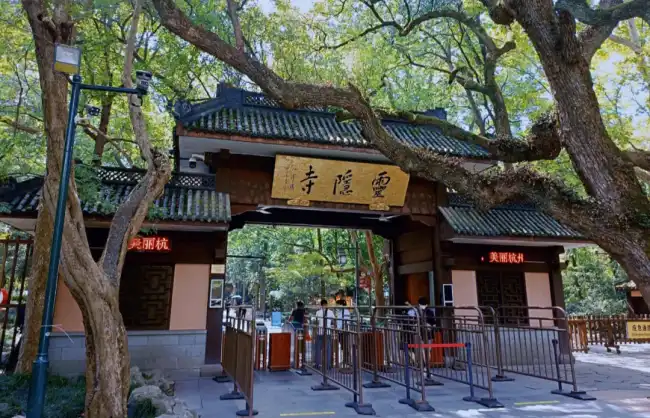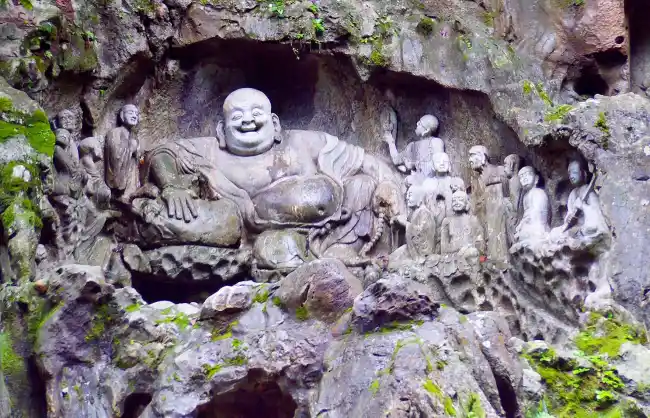Lingyin Temple plays an important role in the Buddhist history of China. Founded in 326 AD, Lingyin Temple is the earliest famous temple in Hangzhou. The temple is situated at the west end of the West Lake and faces the Feilai Peak.
The architecture of Lingyin Temple is majestic, combining exquisite structure and carving art. There are a large number of Buddhist statues and murals, which are precious relics for the study of ancient Chinese Buddhist art and culture. As one of the major temples of Zen Buddhism in China, Lingyin Temple also holds various Buddhist events every year.
Lingyin Temple is a must-see attraction on your trip to Hangzhou. Here explore the splendid Buddhist history and immerse yourself in the serene atmosphere.
Fast Facts of Lingyin Temple in Hangzhou
- In Chinese: 灵隐寺(líng yǐn sì)
- Location:1 Fayun Alley, Lingyin Road, Xihu District, Hangzhou City, Zhejiang Province, China
- Opening hours: 06:30- 17:30
- Ticket price: 45 yuan for Feilai Peak Scenic Area and 30 yuan for Lingyin Temple(free for children under 1.2 meters)
- Time Needed: 2- 3 hours
- Best time to visit: Marchto November
- Suited to: Buddhists, history lovers, culture lovers

History of the Lingyin Si Temple
Lingyin Temple was founded in the Eastern Jin Dynasty (326 AD) by Master Huili, an Indian monk. After that, Lingyin Temple was rebuilt and expanded several times. During the Song Dynasty, Lingyin Temple became a holy place of Zen Buddhism in China. During this period, many Buddhists from home and abroad came to visit the temple.
During the Qing Dynasty, the Chan Master Jude took charge of the temple. Under his leadership of eighteen years, Lingyin Si Temple was completely rebuilt, arriving at its largest scale. Now the temple becomes the China Cultural Heritage. The architectural and cultural relics of Lingyin Temple is properly maintained.
What to See and Do in Lingyin Temple
Explore Grotto Statues of the Feilai Peak Scenic Area
Feilai Peak Scenic Area is the way to Lingyin Si Temple. The Statues of Feilai Peak is the most famous attraction here. More than 380 Buddhist statues from the Five Dynasties to the Yuan Dynasty can be seen, which is the largest group of statues in Zhejiang Province.
Strolling along the path, you will admire the Buddha statues carved into the rocks in vivid shapes and various styles. The earliest carvings are the three statues of Amita Buddha, Bodhisattva and Mahasthamaprapta, which were made in 951 AD. Maitreya Buddha is the largest of the Feilai Peak statues.
The Hall of Heavenly Kings
The Hall of Heavenly Kings is one of the main buildings of Lingyin Temple. In front of the hall, there is a plaque “Yunlin Zen Temple” inscribed by Emperor Kangxi of the Qing Dynasty. The Hall of Heavenly Kings is grand, with a roof covered with glazed tiles and lintels decorated with colorful murals.
The hall enshrines a statue of Maitreya Buddha, a statue of Vitasoka, and statues of the Four Heavenly Kings. As one of the entrances to Lingyin Temple, it is a hall with deep Buddhist cultural heritage. Various Buddhist ceremonies are held at The Hall of Heavenly Kings.
The Grand Hall
The Grand Hall is one of the most spectacular architecture in Lingyin Temple, also known as Hall of Great Sage. The architectural structure of the hall is the traditional Chinese timber structure with a large interior space. The hall enshrines the statue of Shakyamuni Buddha, which is 19 meters high. There are also statues of Manjusri Buddisattva and Samandhabatra Buddhisattva, which are vivid and majestic.
Buddhist murals in the hall are exquisite, reflecting the charm of Buddhist art. The Grand Hall is the place where the monks engage in their daily Buddhist practices. It is a must-visit place for Buddhists who come to worship.
Other Buddhist Halls and Architectures
The Hall of Medicine Buddha is located on the east side of The Grand Hall, which is another major building of Lingyin Temple. The hall enshrines the statue of Medicine Buddha, which is 8 meters high. The Hall of Five Hundred Arhats is a place in Lingyin Temple that shows Buddhist Arhan culture. There are five hundred statues of Arhats in various forms.
The Hall of Master Ji Gong enshrines the statue of Master Daoji, a famous monk in the history of Lingyin Temple. Fangshengchi in Lingyin Temple is one of the common facilities, which is usually a human-made pond. Buddhists can release various aquatic animals into ponds to symbolize their mercy.
Admire Natural Landscape of Lingyin Temple
You will also take many wonderful photos in Lingyin Si Temple. Lingyin Temple is surrounded by mountains and streams, creating a beautiful landscape. Trees in the temple are lush and have a long history. Stroll through the Lingyin Temple to immerse in the serene atmosphere with fresh air.
You can climb up the path to the top of Feilai Peak and overlook the whole Lingyin Temple and the surrounding landscapes. Also take a cable car to reach the North Peak and enjoy the stunning view of West Lake.

Best Time to Visit Lingyin Temple
The best time to visit Lingyin Temple is spring (March to May) and fall (September to November). In spring, the weather in Hangzhou is pleasant. At this time, colorful flowers bloom in Lingyin Temple, such as magnolias and begonias. The Shorea Robustas are famous ancient trees in Lingyin Temple, which only blooms in March to April.
In autumn, the weather in Hangzhou is cool. The maple leaves of Lingyin Temple turn red, forming an attractive view with the surrounding trees. And the ginkgo leaves turn golden, shimmering in the sun.
Spring and fall are also good seasons to explore other attractions during your Hangzhou tours.
How to Get to Lingyin Temple
By Taxi
The distance between Hangzhou Lingyin Temple and Hangzhou Xiaoshan International Airport is 35 kilometers. It will take you about 1 hour and cost you 75 to 100 RMB by taxi.
It will take 35 min and cost 24-35 RMB from Hangzhou East Railway Station to Lingyin Temple by taxi. And it will take 30 min and cost 23-30 RMB from Hangzhou Railway Station to Lingyin Temple by taxi.
By Bus
There are many buses to Lingyin Temple. From Hangzhou Railway Station to Lingyin Temple, you can take bus No.7, which takes 1 hour and 6 min.
If you’re traveling from Hangzhou East Railway Station, you can take bus No.28 and then transfer to bus No.7 to reach Lingyin Temple, which takes 1 hour and 26 min. If you start from the downtown Hangzhou, you can take bus No.71 and later transfer to No.7 to reach Lingyin Temple, which will take 1 hour and 30 minutes.
Attractions nearby Lingyin Temple
Feilai Peak Scenic Area: Feilai Peak Scenic Area is a famous scenic spot in the West Lake District of Hangzhou with beautiful natural scenery. It has a profound Buddhist culture and is famous for its rich Buddhist grotto statues.
Northern Peak: With a height of 314 meters, Northern Peak is considered a relatively high mountain around West Lake. Wander along the path to enjoy the magnificent natural landscape along the way. Climbing to the top of the mountain, you can admire a panoramic view of the West Lake.
Yongfu Temple: Yongfu Temple has a history of over 1,600 years and is located in the Feilai Peak Scenic Area. The architectural complex of Yongfu Temple is divided into five courtyards. Enjoy the beautiful scenery here while learning about the splendid Zen Buddhism.
Longjing Tea Village: Longjing Tea Village is located in the southwest of West Lake, surrounded by mountains on all sides. The village is famous for its top-grade Longjing tea. Longjing tea produced by the village is bright green in color and fresh in flavor.









